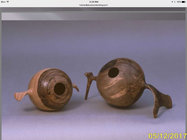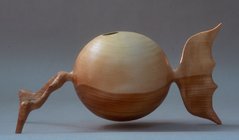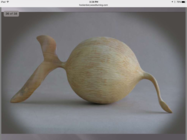What has been your “aha” moment in regards to success in bowl turning or even being safe?
I’d like to compile some great bullet points.
I’d like to compile some great bullet points.
OR: "How to multiply the number of blanks and reduce shaving waste..."Coring systems.



Those are so cool!My turning life is full of aha moments
0ne was sort of a year long in the making it to aha - let the tool do the work
1994 - class with Liam O’Neil I was holding the gouge too tightly - he had me turn the outside of 2 bowls 1 handed from 12” diameter down to about 3”.
1995 - class with David Ellsworth - I’d regressed a bit. He had me hollow a bowl 1 handed.
a few months after seeing Soren Berger turn a scoop Based on a round ball in a vacuum chuck
I thought I could do a two handled scoop using the round ball
Then AHA I can turn hollow form suspended on two legs and hold the ball in a vacuum Chuck for hollowing.
View attachment 40580View attachment 40579View attachment 40581
A number of years ago I watched a demonstration on turning using a foot-powered lathe. I was astounded at the quality of the objects turned. With that in mind I asked the turner what his secret was.What has been your “aha” moment in regards to success in bowl turning or even being safe?
I’d like to compile some great bullet points.
How are you using Lacer’s skew on a bowl? I have one and can’t imagine using it, or any other skew, on a bowl other than to scrape a tenon.…I had to do some serious "sculpting" with my Alan Lacer Uber Skew and D-Way Large NRS to clean out (most) of the tear-out on my first finished cedar bowl…
I'm really using it more as an NRS to shape the rim, clean up tear-out, and even out the inside bottom. Unconventional, but it works for me. Obviously you have to be super-careful putting that much steel in a spinning bowl, but I'm pretty much always edge-horizontal to the bowl off the tool-rest, and I keep a close eye on both points.How are you using Lacer’s skew on a bowl? I have one and can’t imagine using it, or any other skew, on a bowl other than to scrape a tenon.
Thanks, Ron-I'm very much still learning what works best. I seem to do more shear scraping outside than on the inside of a bowl. I'll try that approach on my next bowl. I've got the Jamieson grind on my 5/8" with the long, swept-back wings that is easy-peasy to shear-scrape with after an edge touch-up, with the handle down and a light touch. The round-nose NRS works better for me in a tight inside curve, though. I'm probably overdue for another humbling lesson with my (strict) mentor. He makes me stick to the fundamentals, and then I go home and come up with my own weird techniques.Aaron Harris - I think you’ll find you can do as good of a job shear scraping with your bowl gouge as with the skew in that situation (bottom of bowl might need a real scraper or NRS, but with a burr they should give a better cut than scraping with your skew). A lot easier with the tool already in your hand too. MHO
Getting the "waste wood out of way" is a great opportunity to practice finish cuts before the "clean cut to the final surface".Recognizing that the vast majority of turning is just getting waste wood out of the way to allow the clean cut to the final surface that you envision
Umm, doesnt keeping your handle low translate to the cut being above center?You can shear scrape the inside of a bowl with a round nose scraper or a ) shape nose. Most important, keep your handle low. If you get above the center line, you get the same catch with it that you can get with a skew when you cut above that center line......
robo hippy
Although at the 'aha' moment, you may not know they are / may be bridges, and the next question is likely not yet formed. I think of the 'aha' ideas more as doors opening into a whole new space with numerous possibilities. I've been interested in tracking how my ideas evolve -- and realizing after the fact that often one path forward is chosen (or even seen), that the 'aha' had offered other paths which are only recognized later.Aha moments aren't what most people think they are. They aren't the solution....but they are the bridge to the next unanswered question that you didn't know was there!
-----odie-----
